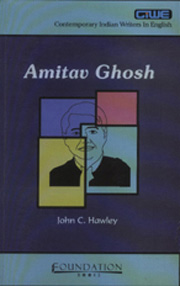Book contents
- Frontmatter
- Contents
- Series Editor's Preface
- 1 The Writer, his Contexts and his Themes
- 2 A Writer Situated in a History and in a Place: Ghosh's Non-fiction
- 3 A Tale of Two Riots: The Circle of Reason and The Shadow Lines
- 4 The Ebb and Flow of Peoples across Continents and Generations: In An Antique Land, The Glass Palace, The Hungry Tide
- 5 Subaltern Agency as Fiction or Science: The Calcutta Chromosome
- 6 Beyond the Commonwealth: Amitav Ghosh and Indian Writing in English
- Topics for Discussion
- Bibliography
3 - A Tale of Two Riots: The Circle of Reason and The Shadow Lines
Published online by Cambridge University Press: 26 October 2011
- Frontmatter
- Contents
- Series Editor's Preface
- 1 The Writer, his Contexts and his Themes
- 2 A Writer Situated in a History and in a Place: Ghosh's Non-fiction
- 3 A Tale of Two Riots: The Circle of Reason and The Shadow Lines
- 4 The Ebb and Flow of Peoples across Continents and Generations: In An Antique Land, The Glass Palace, The Hungry Tide
- 5 Subaltern Agency as Fiction or Science: The Calcutta Chromosome
- 6 Beyond the Commonwealth: Amitav Ghosh and Indian Writing in English
- Topics for Discussion
- Bibliography
Summary
It follows then that the reason why I – and many others who have written of such events – are compelled to look back in sorrow is because we cannot look ahead.
(“The Greatest Sorrow, The Imam and the Indian: 317)The Circle of Reason
Vomited out of their native soil years ago in another carnage, and dumped hundreds of miles away, they had no anger left. Their only passion was memory… Lalpukur could fight no war because it was damned to a hell of longing.
(The Circle of Reason: 59)The Story
When he is eight, “Alu” comes to sleepy Lalpukur from Calcutta to live with his uncle Balaram and aunt Toru-debi. He had been given his nickname by his phrenologist uncle, since his large head looked something like a potato and portended an interesting future – at least, so his uncle thought. His parents had recently died in a car accident. Even though Balaram and his brother had been long-estranged, Balaram and Toru-debi decide to take in Alu and raise him, since they had no children of their own. Alu soon displays an amazing ability to pick up various languages. Yet, in one of the many paradoxes that run through the novel, he rarely speaks at all. When at fourteen the boy stops attending school, Balaram, the supposed scientist, surprises everyone by encouraging the boy to take up weaving. Alu begins by taking lessons from Shombhu-Debnath, a master weaver. Alu seems a gifted child, just as Balaram had predicted: not only is he good at languages (that he doesn't use), but now he also surpasses his teacher in weaving.
- Type
- Chapter
- Information
- Amitav GhoshAn Introduction, pp. 46 - 82Publisher: Foundation BooksPrint publication year: 2005

